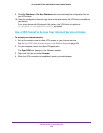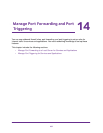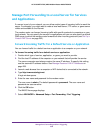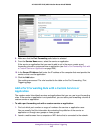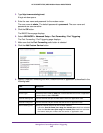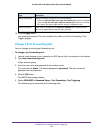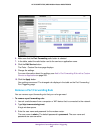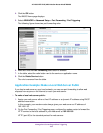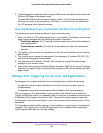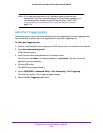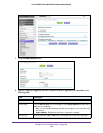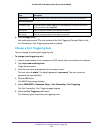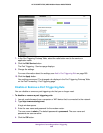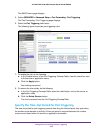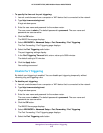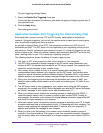
Manage Port Forwarding and Port Triggering
264
AC1600 WiFi VDSL/ADSL Modem Router Model D6400
3. (Optional) Register a host name with a Dynamic DNS service, and specify that name on the
Dynamic DNS page of the modem router.
Dynamic DNS makes it much easier to access a server from the Internet because you
can enter the name in the web browser. Otherwise, you must know the IP address that
the ISP assigned, which typically changes.
How the Modem Router Implements the Port Forwarding Rule
The following sequence shows the effects of a port forwarding rule:
1. When you enter the URL www.example.com in your browser
, the browser sends a web
page request message with the following destination information:
• Destination address.
The IP address of www
.example.com, which is the address of
your modem router.
• Destination port number. 80, which is the standard port number for a web server
process.
2. The modem router receives the message and finds your port forwarding rule for incoming
port 80 traffic.
3. The modem router changes the destination in the message to IP address 192.168.1.123
and sends the message to that computer.
4. Your web server at IP address 192.168.1.123 receives the request and sends a reply
message to your
modem router.
5. Your modem router performs Network
Address Translation (NAT) on the source IP address
and sends the reply through the Internet to the computer or WiFi device that sent the web
page request.
Manage Port Triggering for Services and Applications
Port triggering is a dynamic extension of port forwarding that is useful in these cases:
• An application must use port forwarding to more than one local computer (but not
simultaneously).
• An application must open incoming ports that are different from the outgoing port.
With port triggering, the modem router monitors traf
fic to the Internet from an outbound
“trigger” port that you specify. For outbound traf
fic from that port, the modem router saves the
IP address of the computer that sent the traffic. The modem router temporarily opens the
incoming port or ports that you specify in your rule and forwards that incoming traffic to that
destination.
Port forwarding creates a static mapping of a port number or range of ports to a single local
computer
. Port triggering can dynamically open ports to any computer when needed and
close the ports when they are no longer needed.



